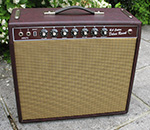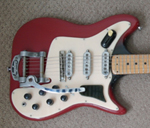Brian
To Standby or Not Standby, that is the question
Moderators: David Martin, Iain Purdon, JimN, dave robinson, George Geddes
17 posts
• Page 1 of 2 • 1, 2
To Standby or Not Standby, that is the question
I noticed comments in another thread recommending NOT using the standby switch on particular amps and am puzzled as to what issues have been caused - perhaps I missed something. Every amp I have had for the past fifteen years and more has come with a standby switch, including an AC30 reissue I had for a while about 10 years ago, and all the amp manufacturers and shops were implicit in recommending powering up with standby switched to off and letting the amp warm up for at least 30 seconds, preferrably more, before switching the standby to ON. I have stuck to this religiously. Why this sudden recommendation to ignore this warning? 
Brian
Brian
-

BrianD - Posts: 282
- Joined: 29 Sep 2009, 06:09
Re: To Standby or Not Standby, that is the question
Without going into the technical reasons the best advice is as follows :-
1. If your valve amp has a semi conductor rectifier, then you should power the amp on with the standby switched to off and leave it for 30 seconds or more before moving it to the on position.
2. On powering on an an amp fitted with a valve rectifier then standby switch should be left in the on position. If you follow the proceedure in 1. above then there is an instantaneous demand for current from the rectifier which over time will greatly reduce its life and place unnecessary stress on the rest of the valves.
Remember that the early Vox AC30s and other amps of that period had no standby switch.
1. If your valve amp has a semi conductor rectifier, then you should power the amp on with the standby switched to off and leave it for 30 seconds or more before moving it to the on position.
2. On powering on an an amp fitted with a valve rectifier then standby switch should be left in the on position. If you follow the proceedure in 1. above then there is an instantaneous demand for current from the rectifier which over time will greatly reduce its life and place unnecessary stress on the rest of the valves.
Remember that the early Vox AC30s and other amps of that period had no standby switch.
-

rogera - Posts: 1056
- Joined: 16 Sep 2009, 13:06
- Location: South West
Re: To Standby or Not Standby, that is the question
Roger,
Many thanks for responding. I am interested in your comments, particularly in light of the reliability issues I have had with my BlackStar Artisan 15 and 30 units - both of which have valve rectifiers and both of which have given me very short lives with regard to the valves. Here is a section from the Artisan 30 User Manual,
16. Standby
This switch applies the H.T. (High Tension) voltage required to produce sound.
Always turn this switch on at least 30 seconds after the Power switch (17) and off at
least 30 seconds before the Power switch. During short breaks in playing use just
this switch to turn ‘off’ and ‘on’ the amplifier’s output.
This is totally contrary to you advice and something I intend to take up with them - if I can!
Brian
Many thanks for responding. I am interested in your comments, particularly in light of the reliability issues I have had with my BlackStar Artisan 15 and 30 units - both of which have valve rectifiers and both of which have given me very short lives with regard to the valves. Here is a section from the Artisan 30 User Manual,
16. Standby
This switch applies the H.T. (High Tension) voltage required to produce sound.
Always turn this switch on at least 30 seconds after the Power switch (17) and off at
least 30 seconds before the Power switch. During short breaks in playing use just
this switch to turn ‘off’ and ‘on’ the amplifier’s output.
This is totally contrary to you advice and something I intend to take up with them - if I can!
Brian
-

BrianD - Posts: 282
- Joined: 29 Sep 2009, 06:09
Re: To Standby or Not Standby, that is the question
A point not mentioned so far in these discussions is where the designer has placed the standby switch in the circuit.
In Standby Circuit 1 , the switch is after the reservoir and smoothing caps
If the rectifier is valve, then with the switch open (standby off) the capacitors will charge slowly as the rectifier warms up. They do not conduct dc so they are not a significant current drain on the rectifier when it is cold (non-conducting) and warming.
Once the rectifier and the output valves are hot, the Standby switch is closed. The output valves immediately want to draw current but this initial surge can be supplied both by the rectifier and by the capacitors. The initial load is shared and the rectifier is not stressed. With Circuit 1, the Standby switch has a useful role.
On the other hand, if the designer has placed the switch immediately after the rectifier, as in Standby Circuit 2, then this is not good for the rectifier
If the standby switch is closed when the valves are hot, the rectifier has to withstand both the sudden drain from the output valves and the instantanious charging current need by the capacitors. Result - a short life for the rectifier. With Standby Circuit 2, it is better to turn on the Mains and Standby switches together.
Semiconductor rectifiers can be made to withstand higher peak currents, so the difference between Circuits 1 and 2 are not important in the same way.
Regarding the amplifiers in question, which type of circuit have the designers given them?
Ray L
In Standby Circuit 1 , the switch is after the reservoir and smoothing caps
If the rectifier is valve, then with the switch open (standby off) the capacitors will charge slowly as the rectifier warms up. They do not conduct dc so they are not a significant current drain on the rectifier when it is cold (non-conducting) and warming.
Once the rectifier and the output valves are hot, the Standby switch is closed. The output valves immediately want to draw current but this initial surge can be supplied both by the rectifier and by the capacitors. The initial load is shared and the rectifier is not stressed. With Circuit 1, the Standby switch has a useful role.
On the other hand, if the designer has placed the switch immediately after the rectifier, as in Standby Circuit 2, then this is not good for the rectifier
If the standby switch is closed when the valves are hot, the rectifier has to withstand both the sudden drain from the output valves and the instantanious charging current need by the capacitors. Result - a short life for the rectifier. With Standby Circuit 2, it is better to turn on the Mains and Standby switches together.
Semiconductor rectifiers can be made to withstand higher peak currents, so the difference between Circuits 1 and 2 are not important in the same way.
Regarding the amplifiers in question, which type of circuit have the designers given them?
Ray L
Last edited by RayL on 09 Nov 2010, 10:10, edited 2 times in total.
-

RayL - Posts: 1250
- Joined: 16 Sep 2009, 16:25
- Location: Carshalton, Surrey
Re: To Standby or Not Standby, that is the question
The additional information that Ray has provided is perfectly true although I believe that the amount of people that will be aware whether they have standby cct. 1 or standby cct. 2 is very small.
Even when an amplifier is fitted with a Standby circuit 1, leaving the standby switch in the on position when powering up will do no damage due to the fact that as the rectifier heater warms up (along with the other valves in the circuit) the ht voltage will ramp up gently causing no stress to components.
Regarding semi-conductor rectifiers it is true that they can withstand greater instantaneous current and may not be damaged themselves, but when an amp of this type is powered up with the standby switch in the on position the full ht voltage is applied almost immediately to the valves in the circuit before they have had any chance of warming up. In that situation the ht voltage tends to start stripping electrons from the cathodes of the valves and does cause gradual damage.
Brian, I've sent you a PM.
Even when an amplifier is fitted with a Standby circuit 1, leaving the standby switch in the on position when powering up will do no damage due to the fact that as the rectifier heater warms up (along with the other valves in the circuit) the ht voltage will ramp up gently causing no stress to components.
Regarding semi-conductor rectifiers it is true that they can withstand greater instantaneous current and may not be damaged themselves, but when an amp of this type is powered up with the standby switch in the on position the full ht voltage is applied almost immediately to the valves in the circuit before they have had any chance of warming up. In that situation the ht voltage tends to start stripping electrons from the cathodes of the valves and does cause gradual damage.
Brian, I've sent you a PM.
-

rogera - Posts: 1056
- Joined: 16 Sep 2009, 13:06
- Location: South West
Re: To Standby or Not Standby, that is the question
Surely the point here is that a Standby switch is provided as a aid for the user, rather than as a way of making electronic components last longer?
The Standby switch act as a mute for all those occasions when the guitarist wants no sound from the loudspeakers until he/she is ready - no hums, no buzzes , no hiss while the stage is being set.. It avoids turning down the volume on the guitar, or the volume on the amp, when the break comes. The guitar can be left on stage next to the cab without that howlround that reaches maximum volume just as you're about to order from the bar.
And, as a bonus, it makes the valves last longer because they are only working with full operating current when you need them to be.
Roger, agreed about semiconductor rectifiers stripping cathodes - all the more reason for having a Standby switch on amps with this type of rectifier, and using it only after a time delay.
Ray
The Standby switch act as a mute for all those occasions when the guitarist wants no sound from the loudspeakers until he/she is ready - no hums, no buzzes , no hiss while the stage is being set.. It avoids turning down the volume on the guitar, or the volume on the amp, when the break comes. The guitar can be left on stage next to the cab without that howlround that reaches maximum volume just as you're about to order from the bar.
And, as a bonus, it makes the valves last longer because they are only working with full operating current when you need them to be.
Roger, agreed about semiconductor rectifiers stripping cathodes - all the more reason for having a Standby switch on amps with this type of rectifier, and using it only after a time delay.
Ray
-

RayL - Posts: 1250
- Joined: 16 Sep 2009, 16:25
- Location: Carshalton, Surrey
Re: To Standby or Not Standby, that is the question
Thanks Roger(a) and Ray. Just want to point out that valve output stages will generally be wired so they receive their HT from a point before the choke and smoothing caps so the effect of these components on the output valves is diminished.
Roger (Cook)
Roger (Cook)
- RogerCook
- Posts: 485
- Joined: 17 Sep 2009, 09:56
Re: To Standby or Not Standby, that is the question
I use a Boogie Mark V now, which has both valve and solid state rectification - switchable on the fly. The manual is quite insistent about using the standby switch...
David M
-

David Martin - Site Admin
- Posts: 1442
- Joined: 08 Sep 2009, 16:48
- Location: Lincoln
Re: To Standby or Not Standby, that is the question
Why does it clearly state in the manual of my much beloved AC30 cc1
"13) Standby Switch: This switch allows the amplifier to attain the correct working temperature before
applying the H.T. supply. Before connecting the amplifier to the Mains supply, ensure the Power and Standby
switches are in the off position. Turn on the Power switch first and then wait 2–3 minutes before turning on
the Standby switch. Doing this each time you play helps prolong tube life. The Standby switch is also very
useful for playing live as it allows you to keep the valves at a functional temperature between sets."
Who are we to believe, the people who designed and built it or others?
OR.... experience. My CC1 was unplugged by accident while still turned on and the rectifier valve blew the next time I used it. Coincidence? I wonder.
I think I'll stick to what it says in the book
Take care
"13) Standby Switch: This switch allows the amplifier to attain the correct working temperature before
applying the H.T. supply. Before connecting the amplifier to the Mains supply, ensure the Power and Standby
switches are in the off position. Turn on the Power switch first and then wait 2–3 minutes before turning on
the Standby switch. Doing this each time you play helps prolong tube life. The Standby switch is also very
useful for playing live as it allows you to keep the valves at a functional temperature between sets."
Who are we to believe, the people who designed and built it or others?
OR.... experience. My CC1 was unplugged by accident while still turned on and the rectifier valve blew the next time I used it. Coincidence? I wonder.
I think I'll stick to what it says in the book
Take care
- petercreasey
Re: To Standby or Not Standby, that is the question
I always understood that using the standby switch as described by the manafacturer was the best way to preserve tube life and is something that I practice and it seems to work. 
Dave Robinson
-

dave robinson - Posts: 5316
- Joined: 09 Sep 2009, 14:34
- Location: Sheffield
17 posts
• Page 1 of 2 • 1, 2
Who is online
Users browsing this forum: No registered users and 64 guests
These advertisements are selected and placed by Google to assist with the cost of site maintenance.
ShadowMusic is not responsible for the content of external advertisements.



